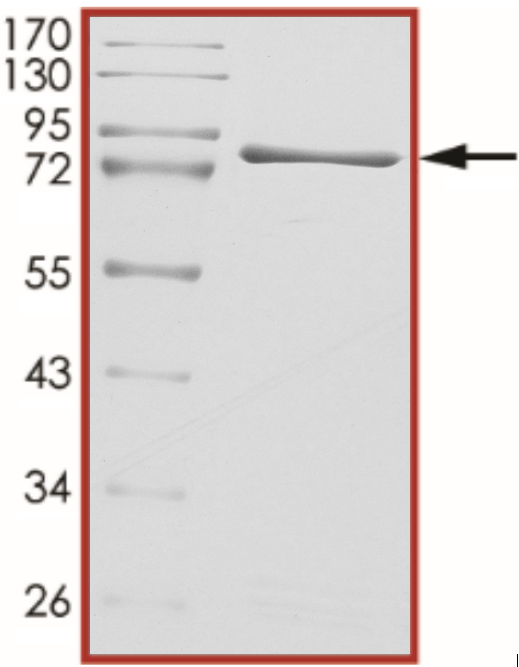Recombinant Human Active Src Protein, CF Summary
Product Specifications
Analysis
Using an N-terminal GST tag
Product Datasheets
Carrier Free
CF stands for Carrier Free (CF). We typically add Bovine Serum Albumin (BSA) as a carrier protein to our recombinant proteins. Adding a carrier protein enhances protein stability, increases shelf-life, and allows the recombinant protein to be stored at a more dilute concentration. The carrier free version does not contain BSA.
In general, we advise purchasing the recombinant protein with BSA for use in cell or tissue culture, or as an ELISA standard. In contrast, the carrier free protein is recommended for applications, in which the presence of BSA could interfere.
4595-KS
| Formulation | Supplied in 50 mM Tris-HCl (pH 7.5), 150 mM NaCl, 10 mM Glutathione, 0.1 mM EDTA, 0.25 mM DTT, 0.1 mM PMSF, and 25% Glycerol. |
| Shipping | The product is shipped with dry ice or equivalent. Upon receipt, store it immediately at the temperature recommended below. |
| Stability & Storage: | This product is stable at ≤ ‑70 °C for up to 1 year from the date of receipt. For optimal storage, aliquot into smaller quantities after centrifugation and store at recommended temperature. Avoid repeated freeze-thaw cycles. |
Assay Procedure
- Active Kinase - Active Src (0.1 μg/μL) diluted with Kinase Dilution Buffer X (1X). Note: These are suggested working dilutions and it is recommended that the researcher perform a serial dilution of Active Src for optimal results.
- Kinase Assay Buffer II - Buffer components: 25 mM MOPS, pH 7.2, 12.5 beta -glycerol-phosphate, 20 mM MgC12, 12.5 mM MnC12, 2 mM EDTA. Add 0.25 mM DTT to Kinase Assay Buffer prior to use.
- Kinase Dilution Buffer IV - Kinase Assay Buffer II diluted at 1:4 ratio (5X dilution) with 50 ng/μL BSA solution.
- 10 mM ATP Stock Solution- Prepare ATP stock solution by disolving 55 mg of ATP in 10 mL of Kinase Assay Buffer II. Store 200 μL aliquots of ≤-20 °C.
- [33P]-ATP Assay Cocktail - Prepare 250 uM [33P]-ATP Assay Cocktail in a designated radioactive area by adding the following components: 150 μL of 10 mM ATP Stock Solutions, 100 μL [33P]-ATP, 5.75 mL of Kinase Assay Buffer II.Store 200 μL aliquots of ≤-20 °C.
- Substrate - Src synethic peptide substrate diluted in 20 mM Tris-HCI, pH 7.5 to a final concentration of 1 mg/mL.
Scientific Data
Reconstitution Calculator
Background: Src
The Src family belongs to non-receptor tyrosine kinases. Src was originally identified as a transforming protein of the Rous Sarcoma Virus (RSV) that had the enzymatic ability to phosphorylate tyrosine in protein substrates (1). Src is over-expressed and activated in a large number of human malignancies and has been linked to the development of cancer and progression to distant metastases (2). In addition to increasing cell proliferation, a key role of Src in cancer seems to be the ability to promote invasion and motility, functions that might contribute to tumor progression.
- Collett, M.S. et al. (1978) Proc. Natl. Acad. Sci. USA 75:2021.
- Jacobs, C. et al. (1983) Cancer Res. 43:1696.
Citations for Recombinant Human Active Src Protein, CF
R&D Systems personnel manually curate a database that contains references using R&D Systems products. The data collected includes not only links to publications in PubMed, but also provides information about sample types, species, and experimental conditions.
3
Citations: Showing 1 - 3
Filter your results:
Filter by:
-
Cell adhesion suppresses autophagy via Src/FAK-mediated phosphorylation and inhibition of AMPK
Authors: M Zhao, D Finlay, E Kwong, R Liddington, B Viollet, N Sasaoka, K Vuori
Cellular Signalling, 2021-10-18;89(0):110170.
Species: Human
Sample Types: Whole Cells
Applications: Bioassay -
Gold nanoparticles-based electrochemical method for the detection of protein kinase with a peptide-like inhibitor as the bioreceptor
Authors: K Sun, Y Chang, B Zhou, X Wang, L Liu
Int J Nanomedicine, 2017-03-09;12(0):1905-1915.
Applications: Bioassay -
Sepsis-induced cardiac mitochondrial dysfunction involves altered mitochondrial-localization of tyrosine kinase Src and tyrosine phosphatase SHP2.
Authors: Zang Q, Martinez B, Yao X, Maass D, Ma L, Wolf S, Minei J
PLoS ONE, 2012-08-27;7(8):e43424.
Species: Rat
Sample Types: Mitochondria
Applications: Bioassay
FAQs
No product specific FAQs exist for this product, however you may
View all Proteins and Enzyme FAQsReviews for Recombinant Human Active Src Protein, CF
There are currently no reviews for this product. Be the first to review Recombinant Human Active Src Protein, CF and earn rewards!
Have you used Recombinant Human Active Src Protein, CF?
Submit a review and receive an Amazon gift card.
$25/€18/£15/$25CAN/¥75 Yuan/¥2500 Yen for a review with an image
$10/€7/£6/$10 CAD/¥70 Yuan/¥1110 Yen for a review without an image











